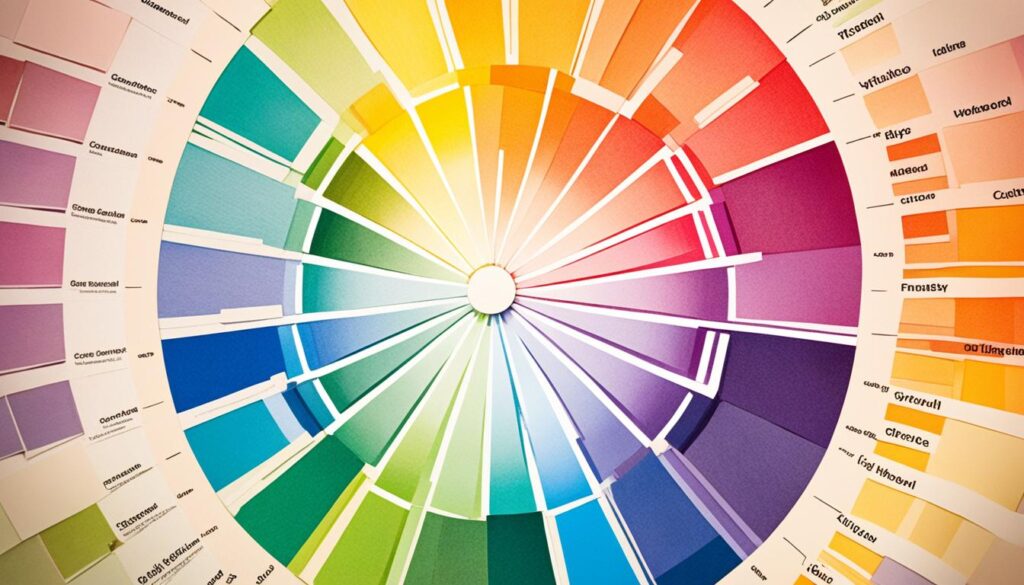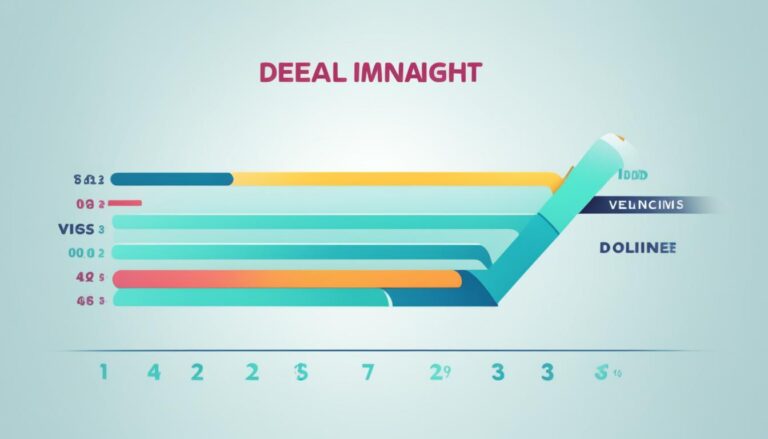The Role of Color in Animated Explainer Videos
Choosing the right colors for animated explainer videos is very important. It helps in grabbing the viewers’ attention and strengthens the video’s message. Knowing about color theory, combinations, and the psychology behind colors can make videos more impactful and appealing.
Colors are also key in making your brand stand out and conveying the right emotions and tone. They play a big role in how people perceive your video’s message.
Key Takeaways:
- Color selection in animated explainer videos can reinforce the message and attract viewers.
- Understanding color theory and combinations is essential for creating harmonious video visuals.
- Different color schemes can evoke specific emotions and create visual contrast in videos.
- Colors can be utilized to enhance brand recognition and establish a cohesive visual identity.
- Consider factors like video theme and mood when selecting colors for animated explainer videos.
The Basics of Color Theory
Color theory is vital for choosing and applying colors in animations. It’s built on three main ideas: hue, saturation, and brightness. These core concepts define how we see color.
Hue is the name of the color, like red, blue, or yellow. It’s what makes each color unique.
Saturation tells us how rich or dull a color is. Colors full of saturation are bright and eye-catching. Less saturated colors are softer and more subtle.
Value/brightness shows if a color is light or dark. Lighter colors have high brightness, while darker tones are lower in value.
The color wheel visually shows different hues and their relationships. It includes primary colors (red, blue, yellow), secondary colors (orange, green, purple), and mixes of these, called tertiary colors. This tool is essential for making good color choices.
Designers use the color wheel to make color schemes that look good. They might use opposites on the wheel, called complementary colors, side-by-side colors, known as analogous colors, or different shades of the same color, called monochromatic colors.
Knowing color theory is crucial for making effective animated videos. It lets creators pick the best colors that go well together, making animations more engaging and meaningful.
Explaining the Color Wheel
The color wheel is key in color theory. It shows how colors relate to each other and how they can be mixed to look good.
Primary colors are red, blue, and yellow. These base colors, when mixed, create secondary colors: orange, green, and purple.
Tertiary colors come from blending a primary and a secondary color. Examples include red-orange, yellow-green, and blue-violet.
Using the color wheel helps in choosing colors that match well. It guides designers in creating appealing color combinations that can trigger specific feelings and deliver messages clearly.
Color Schemes for Animated Explainer Videos
Choosing the right color scheme is key for animated explainer videos. It grabs viewers’ attention and delivers your message effectively. Let’s look at some popular color choices:
Monochromatic Color Schemes
A single hue with varying shades defines a monochromatic color scheme. It makes videos look unified and deep. Different intensities of one color can create harmony and simplicity. This scheme works well for a clean, sophisticated feel.
Complementary Color Schemes
Complementary color schemes use hues opposite each other on the color wheel. They bring out visual tension and dynamics. This approach highlights key elements, adding vibrancy and energy.
Analogous Color Schemes
Colors next to each other on the wheel form analogous color schemes. This blend is soft, harmonious, and easy on the eyes. It’s great for a balanced, cohesive look in videos. It shows unity and coherence.
Triadic Color Schemes
Triadic color schemes pick three hues equally spaced around the wheel. They create vibrant, exciting visuals. This method gives a dynamic, energetic feel and makes your video pop.
Remember, each color scheme affects your video’s vibe. Your scheme should match the message, mood, and theme. Knowing how color schemes work helps create captivating, engaging videos.
Choosing Colors for Animated Explainer Videos
Choosing the right colors for animated explainer videos is crucial. These colors impact how viewers feel and connect with the video. Here are some key factors to think about:
Company Logo Colors
Using company logo colors in your video can boost brand recognition. It makes the brand more familiar and trusted by viewers. This strategy helps create a sense of reliability and consistency.
Brand Genre Colors
It’s also smart to use colors that match your brand’s industry. This can strengthen your brand’s industry image and connect better with your audience. Choosing industry-specific colors builds credibility and makes your content more believable.
Video Theme Colors
The colors should match the video’s mood and theme. Since colors can trigger different feelings, picking the right ones is key. The right colors can help convey your message and improve the video’s visual appeal.
Combining company logo colors, brand genre colors, and video theme colors makes your video more appealing. These elements help ensure that the video reflects your brand’s identity and connects emotionally with viewers.

The image above shows how video theme colors can enhance an animated explainer video. Choosing the right colors makes the content more engaging and appealing to the audience.
Color Implementation in Animated Explainer Videos
Finding the right balance with colors in animated videos is crucial. Each color should be used thoughtfully to make a pleasing scene. It’s like having a color symphony that enhances the video’s message and grabs attention.
Having color elements of different sizes is key. Mix big, medium, and small elements to keep things interesting. This approach makes the visuals dynamic and keeps viewers focused.
Neutral backgrounds are a must to highlight your chosen colors. Whites, light grays, or blacks make the perfect backdrop. They make the colors pop, keeping the video’s message in the spotlight.
Avoid too bright colors, strong contrasts, and too much gradient. While they may catch the eye at first, they can overshadow the message. The goal is to complement the video’s theme, not distract from it.
A balanced color strategy is vital for animated explainer videos. Select and balance colors wisely, use neutral backdrops, and ensure colors amplify the message. This way, you create a captivating video that speaks to your audience.
Tips for Balancing Color Usage:
- Choose a mix of big, medium, and small color elements
- Utilize neutral backgrounds to make colors stand out
- Avoid overly bright colors, harsh contrasts, and overdone gradients
Case study: Color Choices in an Animated Explainer Video
The Clustermarket video is a great example for studying the impact of color in animated explainer videos. It uses the brand’s main colors, like white, black, and dark blue. These colors help make the company more recognizable to its audience. By choosing these colors wisely, the video presents a unified look that matches the brand’s style.
White plays a crucial role in the Clustermarket video by acting as negative space. This approach lets more vibrant colors, such as red and green, pop and catch the eye. Having white as negative space brings balance and harmony, making the video not just nice to look at but also engaging.
This case study beautifully shows how strategic color choices can boost brand recognition. The video combines the brand’s primary colors with white negative space. This approach makes the brand’s identity and message clear to its viewers. It proves how powerful color can be in making an animated explainer video memorable.
The clever color choices in the Clustermarket video underline the value of color in animated videos. It stresses the need to pick the right color combinations and use white effectively. This strategy helps brands stand out and deliver a strong visual impact to their viewers.
Color Palettes for Animated Explainer Videos
Various color palettes bring different themes and feelings to animated explainer videos. By picking the right colors, animators can make the video more appealing. This makes the audience connect more deeply.
Subtle Themes and Pastel Colors
Videos with gentle themes benefit from pastel colors. These colors, like mint green and baby blue, bring calm and a vintage feel. They make the animation soothing and captivating.
Monochromatic Colors
Monochromatic schemes create harmony by using shades of one color. This unifies the look while showcasing the color’s range. The result is visually coherent and pleasing, setting a particular mood.
Vibrant Colors
Vibrant colors are great for a bold and dynamic effect. When mixed with neutrals, they grab attention and stir emotions. Yet, it’s crucial to use them in moderation to keep the focus.
Using different color palettes adds depth and emotion to animated videos. The right colors should match the message and evoke the desired feelings, making the video unforgettable.
Here’s a table showing color palette examples:
| Palette | Colors |
|---|---|
| Subtle Themes and Pastel Colors |
– Soft pink – Mint green – Baby blue – Lavender |
| Monochromatic Colors |
– Light blue – Medium blue – Dark blue – Navy blue |
| Vibrant Colors |
– Fiery red – Electric blue – Vibrant yellow – Bold orange |
Choosing the right color palette is crucial for effective animated videos. Whether it’s soft pastels, single hues, or bold colors, each option can bring out specific emotions and improve the experience.

Considerations for Color Selection
Choosing the right colors for animated explainer videos is crucial. It makes the videos look good. Paying attention to images, using color filters, and checking out Pinterest can help. This way, animators can make colors work well together in their videos.
Image Selection
Using great images as backgrounds can inspire the colors for videos. These images set the mood. For a calm video, soft hues from nature might be best.
“Images can serve as a starting point for color inspiration, helping to set the tone and evoke emotions in animated explainer videos.”
Good images make videos more immersive and fun to watch. They help tell the story better.
Color Filters
Color filters change the look of a video. They can make colors fit together nicely. For example, a sepia filter adds a warm, old-timey feel. A blue filter, though, makes things look modern and cool.
Filters let animators adjust colors for the right effect. They help get the mood just right.
Pinterest Color Boards
Pinterest is great for color ideas. It has tons of boards full of colors. Animators can see what’s trendy and get new ideas.
Using Pinterest lets animators try out new and interesting color schemes. It opens up new creative possibilities for their work.
| Considerations for Color Selection | |
|---|---|
| Image Selection | Choosing striking images as backgrounds can inspire color palettes that align with the desired mood and theme. |
| Color Filters | Applying filters to images can further enhance the color scheme and create a consistent visual style. |
| Pinterest Color Boards | Keeping an eye on visually appealing color palettes on Pinterest can provide inspiration for future animated explainer videos. |
By focusing on image choices, using filters, and getting inspired by Pinterest, animators can pick great colors. This makes their videos pop.
Applying Color Theory in Animation
Color theory is key in making animations that touch hearts and minds. By choosing the right colors, animators make stories more moving. This helps viewers feel a deeper bond with what they watch.
Colors can show what a character or theme is about. Red and orange can show excitement or love. Blue and green can make things seem calm or peaceful.
Colors also matter in setting up scenes. Keeping colors the same through a story makes everything feel connected. Using different colors to highlight important parts can catch the eye.
It’s also smart to think about what colors mean in different places. What a color means can change around the world. So, animators need to do their homework to tell stories that everyone can enjoy.
Using color theory right helps animators tell stories that really speak to people.
Enhancing the Emotional Impact
Colors can change how we feel about what we’re watching. Each color can bring out different emotions and moods. For example:
- Warm colors like red, orange, and yellow can make us feel excited or full of passion.
- Cool colors like blue, green, and purple can help us relax or feel calm.
- Bright colors like pink, yellow, and neon can make things fun and lively.
- Dark colors like black, deep blue, and gray can make things seem serious or even sad.
Choosing the right colors can make animations much more moving and memorable.
Character Design and Color
Colors tell us a lot about a character. They can show personality traits or their part in the story. How a character looks can tell us who they are.
“Color in character design shows us much about personality, where they come from, or their goals.” – John Smith, Animation Expert
Dark colors might mean a character is bad, while bright colors could show they are the hero. These choices help us get who the characters are. This makes the story more gripping.
Scene Styling and Color Consistency
Keeping the same colors and style in scenes is important. It makes the animation look better and feel right. It helps share the feeling or idea of the story.
Soft colors can make a peaceful scene feel even calmer. Bright and bold colors can make exciting scenes more thrilling.
Keeping styles the same lets viewers know where to look. It makes sure they see what’s important.
Knowing how colors affect us, using them in character designs, and keeping a consistent style makes for great stories.
Conclusion
Color plays a big role in animated explainer videos. It can make a strong visual statement and connect emotionally with viewers. Knowing about color theory helps animators pick the right colors. This makes their message stronger and grabs the audience’s attention. Colors also make the brand more recognizable.
When making these videos, animators look at things like company logos, genre colors, and video themes. Matching the color palette with these elements creates pleasing visuals. It also sparks the right emotions and gets the message across well.
It’s key to use colors smartly to keep the video focused and interesting. The right color scheme makes the story flow smoothly. This keeps viewers hooked from start to finish.
To wrap it up, color theory is very important in animated explainer videos. It makes the videos look great and feel emotionally engaging. With the right use of color, animators can share their ideas, make a strong impact, and truly engage their audience.







